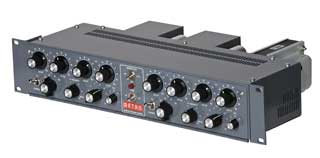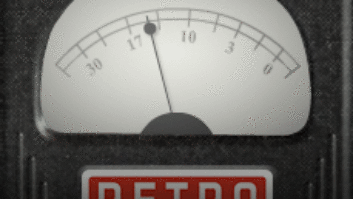
The 2A3 features Pultec-style filters and a switchable highpass filter.
When Retro Instruments set out to design a passive equalizer that captured the sonic character of the vintage Pultec EQP-1A3, the company didn’t strive to create an exact knock-off. Instead, the designer used modern components, included a subsonic filter and added more high-frequency boost filters. The result, the Model 2A3 program equalizer, combines the sweet sound of vintage gear with the enhanced flexibility that comes from a modern design.
Boost and Cut
Passive filters don’t rely on amplifiers to effect tonal shaping; rather, they use capacitors and inductors in separate boost and cut circuits to shape response in specific frequency bands. Aficionados of high-end passive EQs (including myself) cite their smooth, sweet and highly musical sound. The downside to passive circuitry is an inherent loss of level: 40 dB in the 2A3. The 2A3 uses readily available 12AX7 and 12AU7 tubes (two each) to amplify the signal back up to unity gain (+4 dBu with all frequencies nulled). Other tubes may be substituted, with some internal adjustments.
One counter-intuitive use of vintage Pultec equalizers — and the 2A3 — is simultaneous boosting and cutting at the same bass frequency. The boost and cut filters have different slopes and bandwidths so simultaneous boosting and cutting causes a “bass shift” response: The lower-bass band is boosted while frequencies in the adjacent higher band (the middle- to upper-bass or lower-midrange band, depending on the frequency chosen) are cut. The result is thunderous lows and Windex-clear mids.
The dual-mono 2A3 has two boost and two cut frequency bands for each of its channels. Separate rotary boost and cut controls for the lows always affect a common frequency, switchable between 20, 30, 60 and 100 Hz. Your choice of boost and cut frequencies for the highs, however, can be different from one another. You can boost either 1.5, 3, 4, 5, 6, 8, 10, 12, 14 or 16 kHz and cut either 5, 10 or 20 kHz. You can also continuously vary the bandwidth of the high-frequency boost circuit from narrow to broad.
A global bypass for each channel defeats the filters, but not the tube amplifiers or previously mentioned subsonic filter. That filter (an HPF) can be set to 40 or 90 Hz (or completely bypassed) to prevent the buildup of too much subsonic energy. When activated, modest overshoot causes noticeable boost at the corner frequency. Activation also provides transformer coloration as the 2A3’s XLR I/Os (on the unit’s rear panel) are transformer-balanced.
The unit’s boost and cut controls are all continuously variable and are accompanied by 100-position knob scales for exacting manual recall. This feature, plus more than 70 dB of channel separation and the ability to handle whopping +26dBu I/O levels, suggests primary use on a mix bus, which is where I put the 2A3 to the test.
Passive Pleasures
Activating the 40Hz subsonic filter on a contemporary country mix lent a gentle boost to subterranean lows, making bass guitar and kick drum thump nicely. The attendant transformer coloration softened the program’s midrange frequencies, lending flattering warmth. The bottom end was a tad less precise, but the tradeoff was worth it.
Next, I dialed in very modest boost and cut (a little more boost than cut) at 30 Hz. It’s important to know these filters can reach well above 100 Hz with enough gain, influencing the spectral balance even with the subsonic filter engaged. Now the mix was speaking to me in thunderous tones, warming the seat of my chair. Yet the simultaneous cut prevented the upper-bass frequencies from sounding muddy.
Dialing in a very broad bandwidth for highs, I boosted around 5 dB at 16 kHz. Whereas boosting this much with an active equalizer might cause the top end to sound strident, the 2A3 simply lent sweet definition and beautiful air to the lead vocal, cymbals, stringed instruments and reverbs. The combined effect of all my tweaks made my mix sound bigger, warmer and more 3-D.
One for the Rack?
At $3,750, the 2A3 is pricey. But put it on your mix bus and you probably won’t want to take it off. The 2A3 is one sweet-sounding equalizer.
Mix contributing editor Michael Cooper is the owner of Michael Cooper Recording (www.myspace.com/michaelcooperrecording) in Sisters, Ore.

Click the Product Summary image to view the product page







